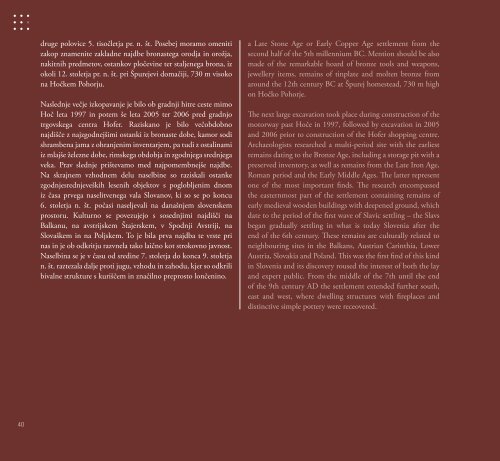Arheološka pot po Mariboru z okolico ... - Življenje na dotik
Arheološka pot po Mariboru z okolico ... - Življenje na dotik
Arheološka pot po Mariboru z okolico ... - Življenje na dotik
You also want an ePaper? Increase the reach of your titles
YUMPU automatically turns print PDFs into web optimized ePapers that Google loves.
40<br />
druge <strong>po</strong>lovice 5. tisočletja pr. n. št. Posebej moramo omeniti<br />
zakop z<strong>na</strong>menite zakladne <strong>na</strong>jdbe bro<strong>na</strong>stega orodja in orožja,<br />
<strong>na</strong>kitnih predmetov, ostankov pločevine ter staljenega bro<strong>na</strong>, iz<br />
okoli 12. stoletja pr. n. št. pri Špurejevi domačiji, 730 m visoko<br />
<strong>na</strong> Hočkem Pohorju.<br />
Naslednje večje izkopavanje je bilo ob gradnji hitre ceste mimo<br />
Hoč leta 1997 in <strong><strong>po</strong>t</strong>em še leta 2005 ter 2006 pred gradnjo<br />
trgovskega centra Hofer. Raziskano je bilo večobdobno<br />
<strong>na</strong>jdišče z <strong>na</strong>jzgodnejšimi ostanki iz bro<strong>na</strong>ste dobe, kamor sodi<br />
shrambe<strong>na</strong> jama z ohranjenim inventarjem, pa tudi z ostali<strong>na</strong>mi<br />
iz mlajše železne dobe, rimskega obdobja in zgodnjega srednjega<br />
veka. Prav slednje prištevamo med <strong>na</strong>j<strong>po</strong>membnejše <strong>na</strong>jdbe.<br />
Na skrajnem vzhodnem delu <strong>na</strong>selbine so raziskali ostanke<br />
zgodnjesrednjeveških lesenih objektov s <strong>po</strong>globljenim dnom<br />
iz časa prvega <strong>na</strong>selitvenega vala Slovanov, ki so se <strong>po</strong> koncu<br />
6. stoletja n. št. <strong>po</strong>časi <strong>na</strong>seljevali <strong>na</strong> da<strong>na</strong>šnjem slovenskem<br />
prostoru. Kulturno se <strong>po</strong>vezujejo s sosednjimi <strong>na</strong>jdišči <strong>na</strong><br />
Balkanu, <strong>na</strong> avstrijskem Štajerskem, v S<strong>po</strong>dnji Avstriji, <strong>na</strong><br />
Slovaškem in <strong>na</strong> Poljskem. To je bila prva <strong>na</strong>jdba te vrste pri<br />
<strong>na</strong>s in je ob odkritju razvnela tako laično kot strokovno javnost.<br />
Naselbi<strong>na</strong> se je v času od sredine 7. stoletja do konca 9. stoletja<br />
n. št. raztezala dalje proti jugu, vzhodu in zahodu, kjer so odkrili<br />
bivalne strukture s kuriščem in z<strong>na</strong>čilno preprosto lončenino.<br />
a Late Stone Age or Early Copper Age settlement from the<br />
second half of the 5th millennium BC. Mention should be also<br />
made of the remarkable hoard of bronze tools and wea<strong>po</strong>ns,<br />
jewellery items, remains of tinplate and molten bronze from<br />
around the 12th century BC at Špurej homestead, 730 m high<br />
on Hočko Pohorje.<br />
The next large excavation took place during construction of the<br />
motorway past Hoče in 1997, followed by excavation in 2005<br />
and 2006 prior to construction of the Hofer shopping centre.<br />
Archaeologists researched a multi-period site with the earliest<br />
remains dating to the Bronze Age, including a storage pit with a<br />
preserved inventory, as well as remains from the Late Iron Age,<br />
Roman period and the Early Middle Ages. The latter represent<br />
one of the most im<strong>po</strong>rtant finds. The research encompassed<br />
the easternmost part of the settlement containing remains of<br />
early medieval wooden buildings with deepened ground, which<br />
date to the period of the first wave of Slavic settling – the Slavs<br />
began gradually settling in what is today Slovenia after the<br />
end of the 6th century. These remains are culturally related to<br />
neighbouring sites in the Balkans, Austrian Carinthia, Lower<br />
Austria, Slovakia and Poland. This was the first find of this kind<br />
in Slovenia and its discovery roused the interest of both the lay<br />
and expert public. From the middle of the 7th until the end<br />
of the 9th century AD the settlement extended further south,<br />
east and west, where dwelling structures with fireplaces and<br />
distinctive simple <strong><strong>po</strong>t</strong>tery were receovered.<br />
Kamnita sekira, kopača in izvrtek, odkriti v S<strong>po</strong>dnjih Hočah (vir: arhiv ZVKDS).<br />
Stone axe, hoe and shafthole blank found in S<strong>po</strong>dnje Hoče (source: the ZVKDS archives).


